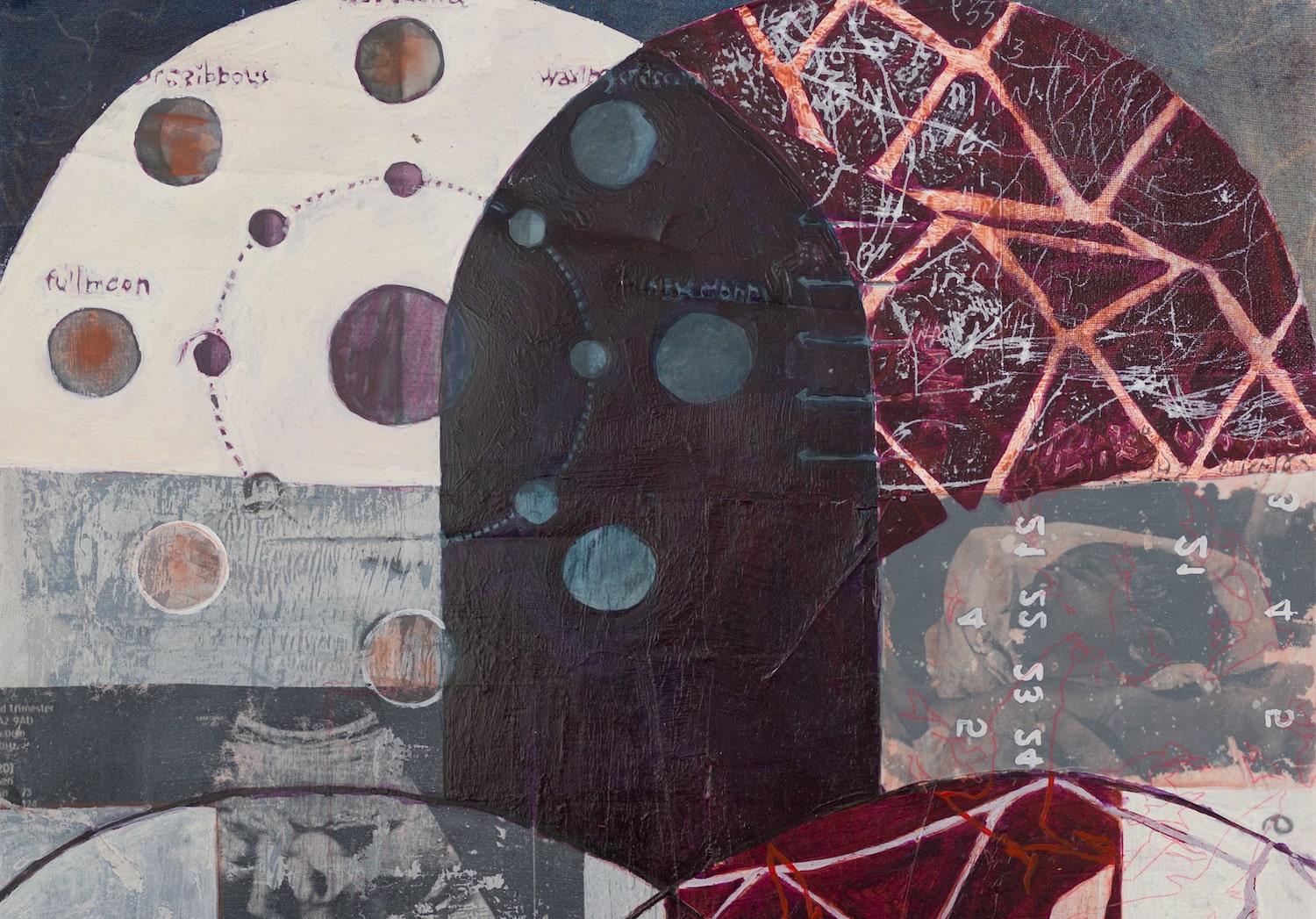At Kate Liebman’s current exhibition at D.D.D.D. in New York, the viewer’s tempo is guided by the show title: “Hopscotch.” There’s a silent invitation to move among the paintings at a comfortable pace, pausing in front of each work long enough to find one’s balance. Visitors are encouraged to view the show in whatever order appeals to them, perhaps randomly, linearly, or intuitively selected like a tarot card.
Regardless of method, recurring motifs offer a home base, a through line for every type of viewer. Time is carefully examined, the findings articulated in acrylic paint, X-rays, drawings, and ancient symbols. On the occasion of “Hopscotch,” Liebman spoke to Whitewall about the stories behind her practice, the passing (or not-passing) of time, misunderstood curiosity, and the reverberations of grief.
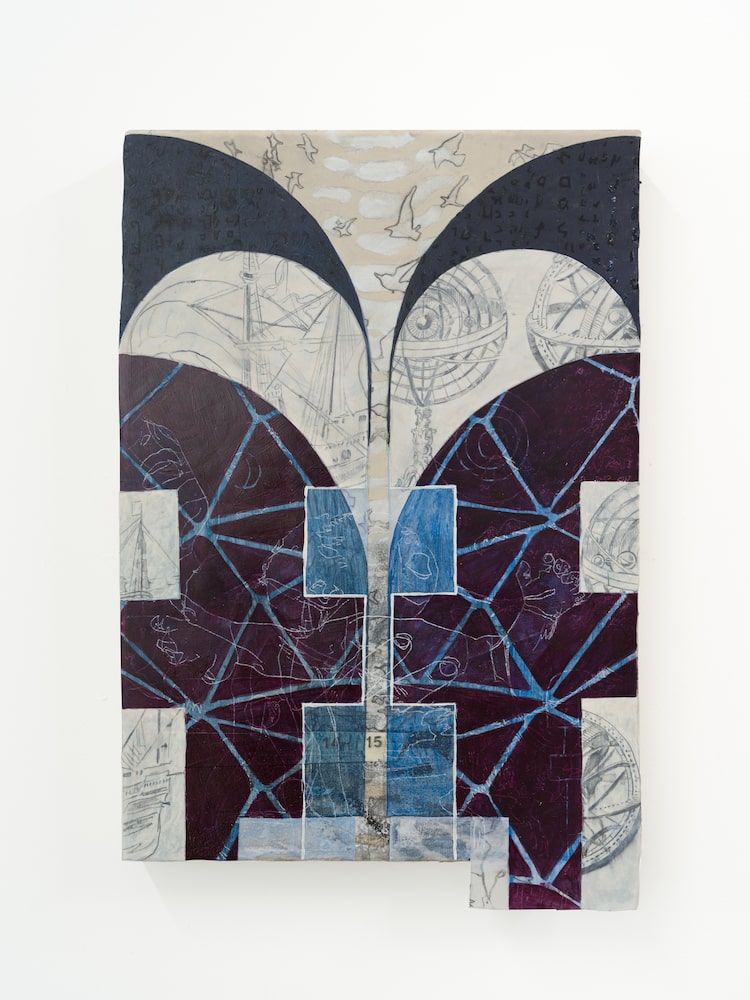
Kate Liebman, “Lit up blue by the strangeness of God,” 2023, acrylic, tape, graphite, xerox transfer on canvas 12 x 17 inches, courtesy of the artist and D.D.D.D.
From Earth to Heaven, Kate Liebman’s Paintings Examine the Passing of Time
WHITEWALL: Let’s start by talking about the title of the exhibition: “Hopscotch.”
KATE LIEBMAN: “Hopscotch” holds multiple meanings for me. The first is as a children’s game, where it symbolizes the passage from Earth to heaven. Kids jump from the first square, or earth, to the last square, which is heaven––they’re playing the passage of life. The second meaning has more to do with the shape of the game. It has both rounded and square parts; it offers an interesting compositional challenge. It contains horizontal and vertical parts, and in that way resembles the crucifix form. Then there are the numbers in each box. There are a lot of numbers in these paintings, especially in thinking about the passage of time. I like that parallel.
The game as a remembered form also interests me––everyone knows how it’s done, but when kids draw it, they draw it with differences. So then memory or misremembering is altering the form. Lastly, I was really inspired by Julio Cortázar’s book, Hopscotch [1963], which can be read two ways: one, by jumping around different chapters, which makes for a really interesting reading experience, and two, by reading part of it straight through as a novel. I was thinking about how the paintings would be seen in D.D.D.D.’s space, which is narrow, and how each painting might resemble a square of hopscotch, a place to stop before jumping to the next one.
Kate Liebman’s Medium Doubles As Timekeeper
WHITEWALL: The paintings incorporate a host of mediums: acrylic, vellum, cyanotype, transfer paper, and graphite. What roles do they play in your compositions?
KL: The work really comes out of drawing and printmaking. There’s an emphasis on line; it comes back to time again. I think of the images on these different materials simultaneously as ghosts, records, palimpsest. Then, a big leap forward in my practice was discovering how to get multiple images on the surface at the same time. As soon as I was able to develop a language for myself, everything became fair game. I could have multiple images from different time periods and different artists and different kinds of diagrams, so scientific diagrams, um, art historical images, x-rays, ultrasound images, tracings of birds––all of these different source materials coming from all parts of our experience. And they can collide and overlap and interact on the surface of the painting the same way or an analogous way to how they exist internally, in the mind.
Cyanotype is visible on some of the edges. Cyanotype is a proto-photographic process where the length of time that the image is exposed dictates how dark or light blue the fabric will become. In that way, the cyanotype is keeping a record of time.
There are also vellum drawings collaged onto the fabric. Vellum is a semi-transparent material, um, and I’ve been making drawings and tracings of a wide variety of images, collaging those onto the surface, and then painting on top of that constructed surface, which already when I begin the painting has so many images layered onto it, kind of physically how memory works. I also include drawings done on transfer paper to build up the image layer. There are Xerox transfers, too––for the x-ray, sonograms, and eye images.
These images and materials are always migrating throughout and layering on the surface of the paintings. In Many Visions, for example, there’s a drawing of the back of the moon collaged onto the surface. I was thinking about many different types of vision: x-ray vision, the eyeball, the back of the moon. These can only be seen with the aid of technology.
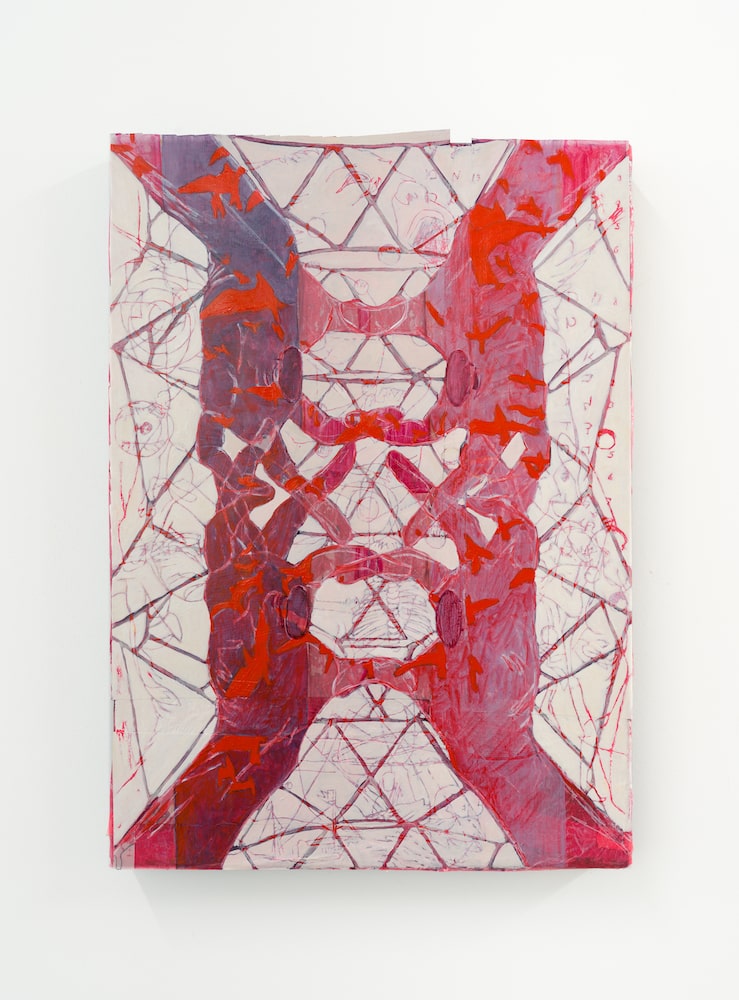
Kate Liebman, “For the Lepers, Again,” 2023, acrylic, transfer paper, graphite, vellum on cyanotype, 12 x 17 inches, courtesy of the artist and D.D.D.D.
WHITEWALL: The passage of time and time-keeping appear consistently throughout this body of work, not only in the “Hopscotch” forms and material, but through historic references. Can you elaborate on those?
KATE LIEBMAN: I wanted these paintings to have a sense of both long time and short time. “Long” being things that happened in mythic time, like the expulsion of Adam and Eve, and “short” being something really grounded in the here-and-now, like an image of an x-ray, in this case of my daughter’s chest.
Materially, I’m using the cyanotype to embed the time element. The images I choose exist in a broader language; they’re coming from a larger image library that I’ve been building up over the past three or four years. There are actual copies of art historical images. Masaccio’s Adam and Eve [1425] reappears frequently. The hands in For the Lepers, Again are from Matthias Grünewald’s Isenheim Altarpiece [1516], where Jesus is painted as a leper.
I’m also interested in how we experience and visualize cyclical time––I use images of the moon, thinking about marking the months without using numbers. Numbers work differently, they mark linear time, a capitalist idea of progress. There’s also the Aramaic script, which comes from tracings of the Kaddish, the prayer that Jews repeat after someone’s death and then annually on the anniversary of their passing. It’s said at a fixed time, and so everything moves in a circle. You go live your life and then you come back to this prayer.
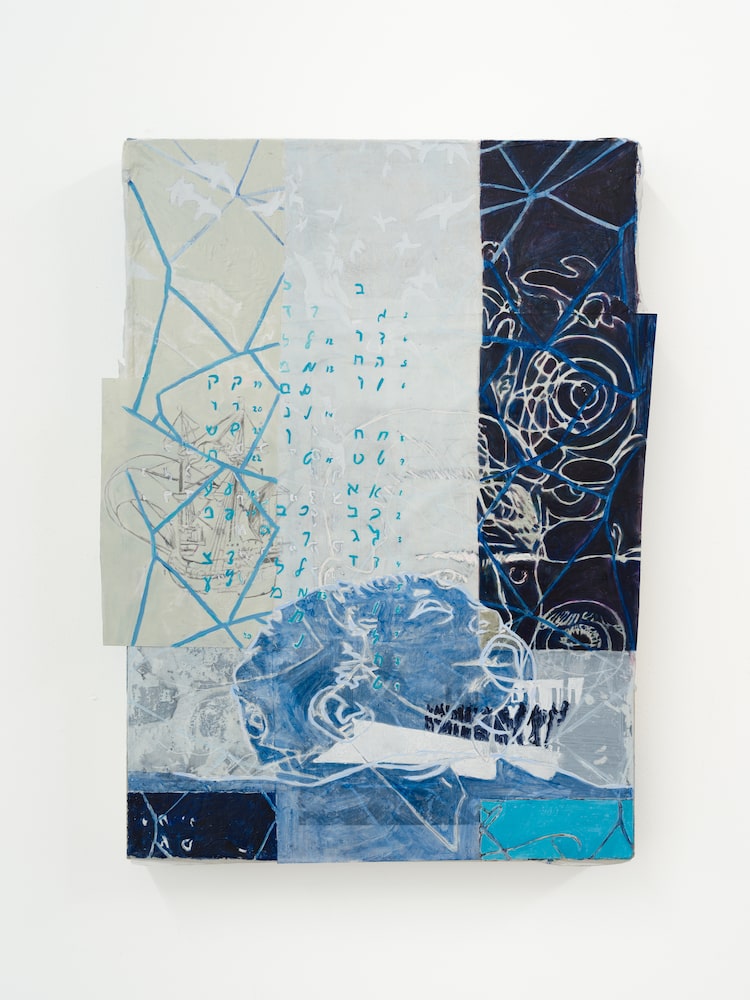
Kate Liebman, “Many Generations 2,” 2023, graphite, pastel, vellum, acrylic, transfer paper, xerox transfer on cyanotype 12 x 17 inches, courtesy of the artist and D.D.D.D.
The Paintings of “Hopscotch” Are Rooted in Ancient Stories
WHITEWALL: The experience of time passing is a difficult idea to analyze, yet you seem to be examining it from every angle. Are there certain experiences that contributed to your understanding of the subject?
KL: My work changed drastically after the death of a loved one. Tremendous grief can completely change your sense of time. It put me in a place where everything was kind of soupy––days and nights, weeks and months, everything blended. I felt like I was stuck, essentially. When the pandemic arrived, time stopped again, and the way I made things really shifted. I had a daughter six months ago; being pregnant was a total time-fuck. Time never went so slow as that.
These are experiences that many people have. One way or another, everyone experiences loss. We globally experienced COVID. Many people become parents. They’re not necessarily unique experiences, and the exact permutations of these experiences are of course unique. For me, they really changed the way that I felt in time. I wanted my work to reflect that.
One of the only ways that I could start to make sense of that loss in particular was through the myth of Icarus, where he is flying with his father Daedalus and Icarus flies too close to the sun. I was thinking about it in terms of the father – his loss, that he can’t stop to mourn but actually must keep flying to escape King Minos. Often it’s interpreted as a story of hubris. Icarus’s father told him not to fly too close to the sun, and he did, so he died. He ignored the warning and pushed the limitations of the material of the wings, so he deserved his death. But I also was thinking about it from the standpoint of curiosity. What if it wasn’t hubris but Icarus just wanted to see the earth from further above? In my grief, there was something happening in my psyche where I was really drawn to these ancient stories.
That collision of different narratives happened to me internally, allowing me to think about images from history and art history made by other people, as well as deeply personal things that are just mine. My hope is that the work, all coming from a deeply personal place for me, opens up for a viewer and allows them to project into the paintings.
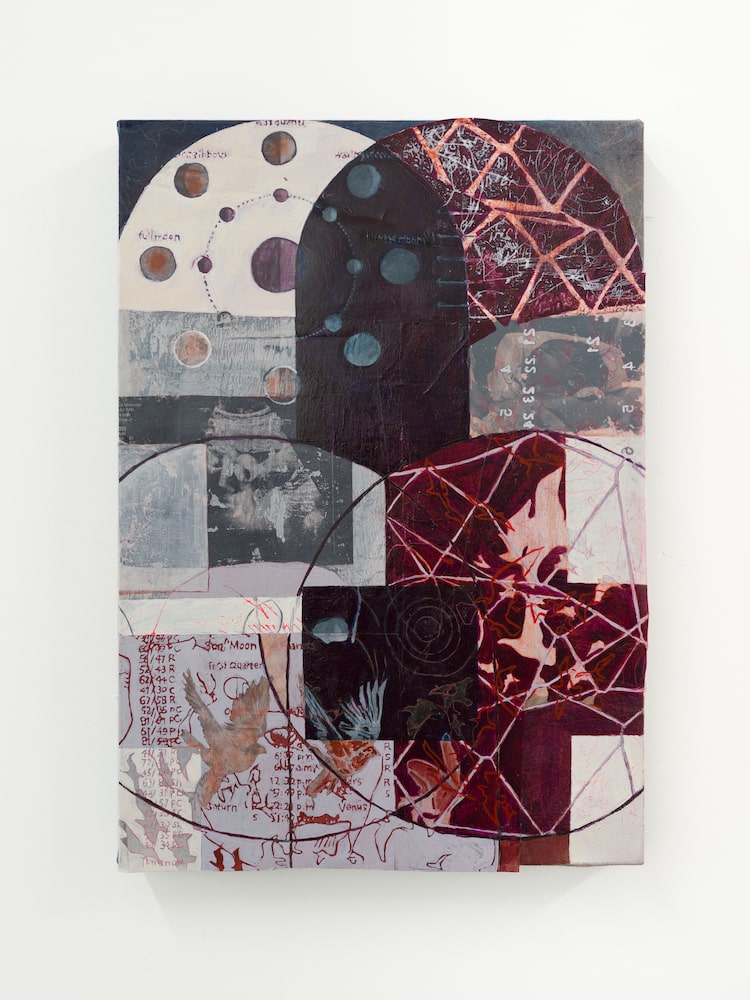
Kate Liebman, “Many Generations,” 2023, acrylic, xerox transfer, vellum, graphite on cyanotype 12 x 17 inches, courtesy of the artist and D.D.D.D.
WHITEWALL: Beyond Cortázar’s Hopscotch and the history and mythology mentioned, are there any consistent influences that you come back to?
KL: I think about books a lot, and this idea of intertextuality where authors are speaking to each other. If you read one book, and then you read something else that the first author was referencing, all of a sudden, the experience of both books becomes richer.
With painters, I come back to Bruegel and his combination of the contemporary and the mythic. In The Fall of Icarus [1560], the boats he painted are the same ones he saw in the harbors. There’s something really appealing to me about that, subtlety. It doesn’t feel gimmicky. Similarly with Grünwald––he painted Jesus as a leper with the painting’s home in mind. Fundamental stories reappearing in every person’s life or in every generation, just under a different guise.
Then I’m always thinking about spirituality and history. Being Jewish is foundational to who I am and how I move through the world, even though I only go to temple a few times a year. There’s something about certain practices within that tradition that really appeal to me, like saying the Kaddish or singing certain songs in Hebrew, a language I don’t speak, or dancing the Hora at important life events. Basically, the traditions that participate in continuity in time. There’s a lot of symmetry in the work, which is a hallmark of certain sacred iconographies. In many of the paintings, I’m thinking about stained glass windows and how images are put together in pieces.
Kate Liebman: “Hopscotch” remains on view at D.D.D.D. at 179 Canal St Ste 3B/4D, New York, NY 10013 through February 19, 2024.
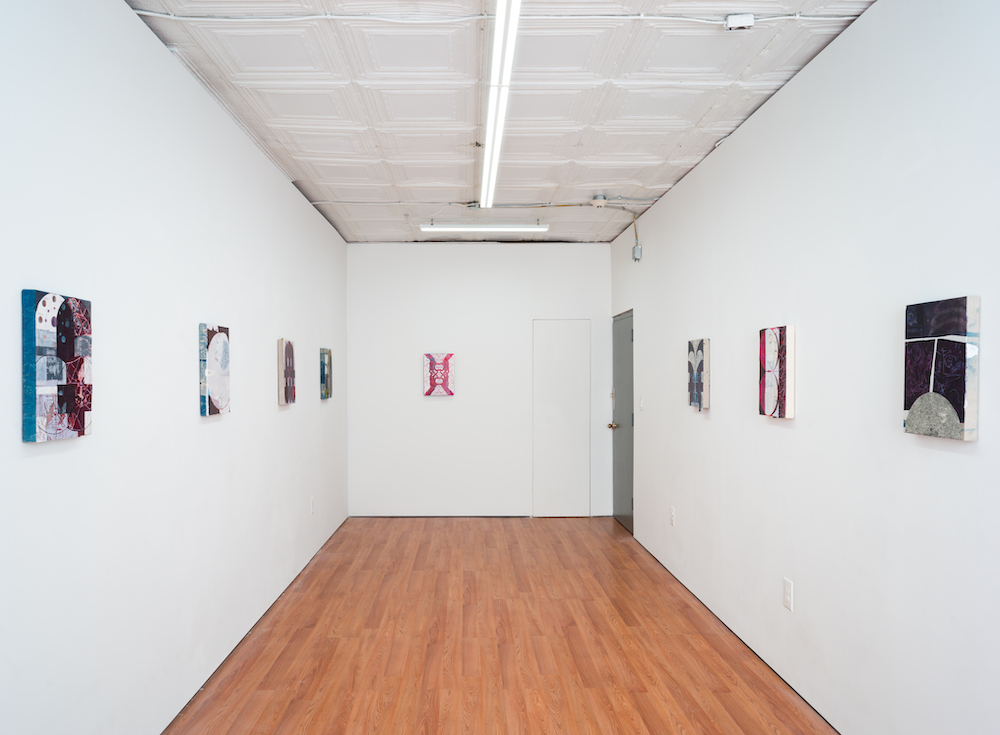
Installation view of Kate Liebman’s “Hopscotch” at D.D.D.D., courtesy of D.D.D.D. and the artist.


